The LG G8 Review: Solid, But Not Great
by Andrei Frumusanu on April 30, 2019 1:00 PM EST- Posted in
- Mobile
- LG
- Smartphones
- LG G8
- LG G8 ThinQ
Display Measurement
As mentioned before, the G8 is a special device for LG as it represents the very first G-series phone which comes with an OLED screen. This is quite intriguing but also worrisome as the company hasn’t had a great track-record with OLED displays, suffering either from display quality issues or from power consumption issues.
For the new G8 to be considered a worthwhile consideration, it needs to get the display right. Thankfully, when it comes to the quality of the display panel (Uniformity), the phone doesn’t showcase any issues, which leaves display calibration as well as power consumption the remaining deciding factors.
As always, we thank X-Rite and SpecraCal, as our measurements are performed with an X-Rite i1Pro 2 spectrophotometer, with the exception of black levels which are measured with an i1Display Pro colorimeter. Data is collected and examined using SpectraCal's CalMAN software.
Compared to the G7’s LCD screen, one expected degradation from the move to an OLED screen is lower brightness levels, as the G7’s RGBW display showcased some class-leading display brightness reaching up to 1000 nits at 100% APL white.

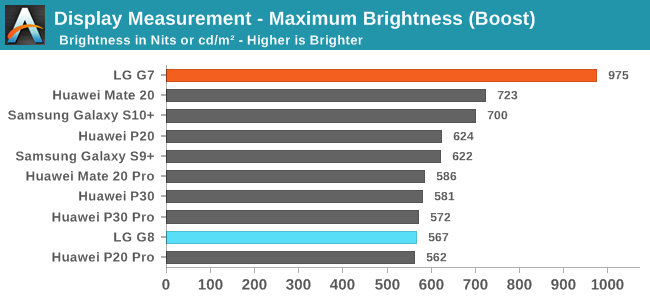
In manual maximum brightness, the G8 goes up to 388 nits when displaying full white, while when in bright conditions under the automatic mode the display boosts up to 567 nits. While per se the figures aren’t bad, the G8 does lag behind the newer Samsung S10 and also especially lags behind the G7’s incredibly high brightness levels.
In bright daylight situations I found the G8 to be acceptable, but not outstanding. It’s to be noted that LG scales brightness very aggressively with varying APL (average picture level), but even in lower APL levels the phone just isn’t as bright as competing devices.
In terms of display calibrations, LG offers a grand total of 7 different display modes, including “Auto”, “Cinema”, “Sports”, “Game”, “Photos”, “Web” and a more customisable “Expert”.
Among all of these, “Web” is the only sRGB gamut target display mode, while the “Cinema” mode seemingly targets a more accurate Display P3 profile. We’re limiting our evaluation to these two modes as they represent the most accurate modes on the G8.
Colour balance on the G8 unfortunately is a major issue, and although the “Web” profile showcases the best white-balance, it’s still veering off towards blues with a higher 6847K average CCT. The colour balance isn’t an issue of the profile but seemingly an issue of the calibration, as the display is able to showcase near perfect whites when at maximum brightness, with an ever increasing deviation the lower the brightness goes.
Gamma is also a major issue for the G8. At 200 nits, the phone is massively off-target with a 2.7 average gamma, with mid-levels exceeding 2.8, meaning tones appear darker than they should be. Again this issue is highly dependent on brightness as it’s not nearly as pronounced at maximum brightness.

The end greyscale accuracy score for the G8 ends up at a measly DeltaE2000 of 4.85. While this is an improvement over the G7’s atrocious calibration, it’s still quite bad. This time around it’s not the colour balance that is the worst offender, but rather the massively off-mark gamma.
As mentioned, the “Web” profile is the only mode which offers a target gamut seemingly aiming for sRGB. However things are still quite off the mark here as it overshoots the gamut in the greens, and ever so slightly in the reds. What is again the key offender here isn’t this slightly larger-than-sRGB gamut, but rather the fact that the saturations are non-linear, showing some clear saturation compression which tends to oversaturate all levels.
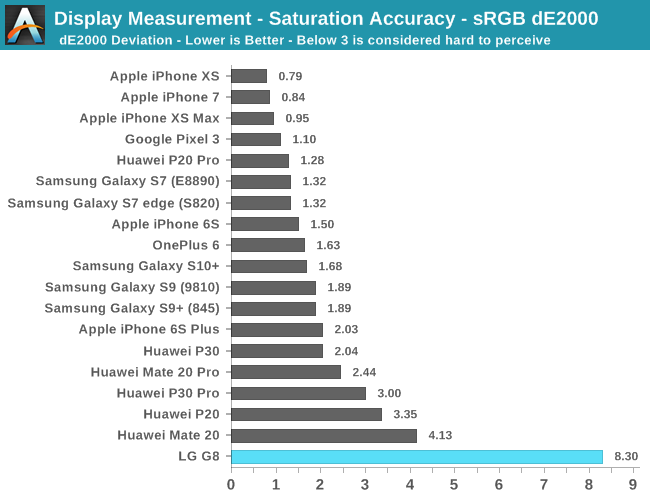
The resulting deltaE2000 is one of the worst we’ve ever measured, reaching 8.3 which is borderline unacceptable.
The “Cinema” mode offers the most accurate Display P3 gamut profile, and here again we’re seeing the same issues as on the “Web” profile. LG again overshoots the gamut in the greens, although this time doesn’t reach the target red levels. We see the same saturation compression issue with non-linear levels which means lower tone levels are just much too oversaturated.
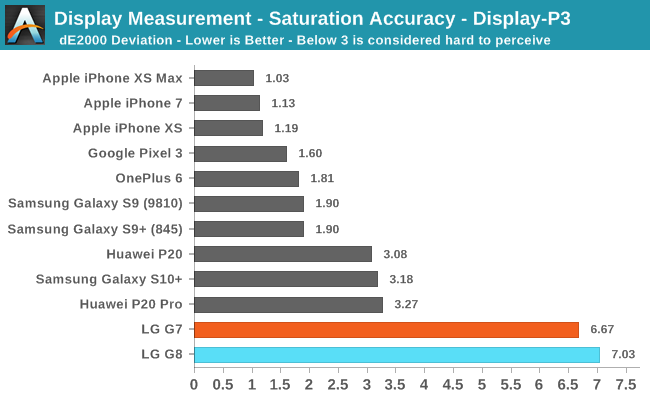
Here we have a comparison to the G7 (The phone didn’t have an sRGB mode), and shockingly it fares even slightly worse in terms of colour accuracy than last year’s disastrous result, with a dE2000 of 7.03.

Finally, in our Gretag-Macbeth test of commonly found tones such as skin tones, the G8 is just an outright disaster. I would like to point out to the detailed dE2000 results of the individual tones which exceed 10 and some even reach values of up to 15.
While most tones aren’t too terrible in terms of their target hue, their saturation and luminosity (gamma) are completely off the mark.
The end result is a shameful dE2000 of 8.92, which I think is the worst display calibration we’ve ever measured on a phone. It’s to be noted that the measurements here are done in the “Web” profile, LG’s other profiles are even worse than this.
Overall Display Verdict
While the G8’s display has no issues in terms of uniformity and showcases great viewing angles, and its brightness levels is somewhat acceptable, the phone simply doesn’t have any accurate display mode.
I find it very odd that LG had introduced the new supposedly accurate “Web” profile in the V40 and G8, yet the company only did a half-hearted job in terms of actually making this an accurate display mode. The result is that the G8’s colours are consistently off-mark, with some of the worst calibration results we’ve ever seen in a smartphone.


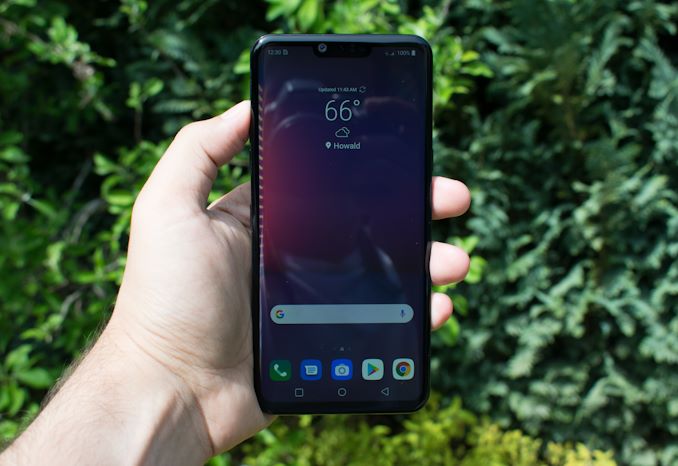
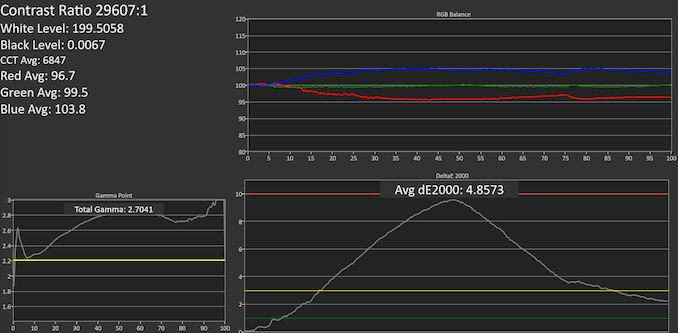

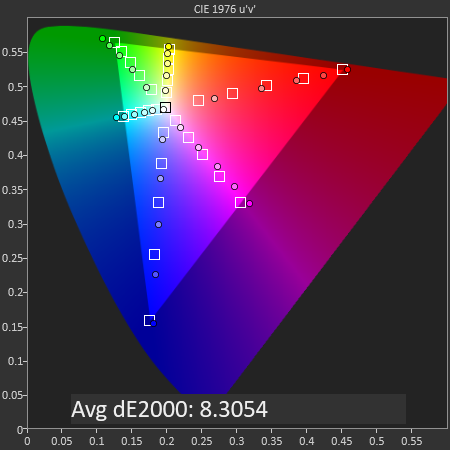

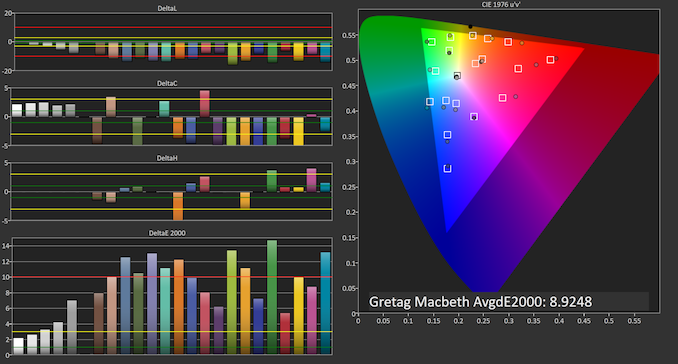









70 Comments
View All Comments
bobsta22 - Friday, May 3, 2019 - link
and in Russia as in USA you will have unfettered access to monitored internet, censored heavily and laughable governments.The Russian 'NSA' is as bad as the USA one.
coburn_c - Tuesday, April 30, 2019 - link
I thought I saw no earpiece in the reveal. Quite a bold move.Gunbuster - Tuesday, April 30, 2019 - link
Fun fact. Other names considered for the G8 ThinQ:G8 You'reWelcomeQ
G8 RIP LGQ
Quantumz0d - Tuesday, April 30, 2019 - link
Wow just not even a word on the 3.5mm jack (just a spec list nod) Huawei didn't include it you mentioned how bad it is and LG of all the OEMs only cared about the Audio Recording in HiFi and processing with ESS Quad DAC9218P. Because people mentioned against your findings on the G7 ?Great.
Even YouTubers like MKBHD gave better credit overall. Especially the price point drop at later point of time.
http://www.esstech.com/index.php/en/news/newsroom/...
Andrei Frumusanu - Tuesday, April 30, 2019 - link
I can't accurately measure high voltage outputs with my setup, and I don't have high impedance headphones to actually need it. With normal headphones the G8 sounds no different or better than say any recent phone with Qualcomm's Aqstic DACs.Don Hrle - Tuesday, April 30, 2019 - link
You poor soul. Even on 5$ chi fi last year G7 with an average lossless file sounds miles ahead of any Qcomm dac. Sometimes it's easier to say: "there's no difference" than "I Know Jack shit bout music quality"Andrei Frumusanu - Tuesday, April 30, 2019 - link
Sometimes it's easier to say "I know jack shit about audio measurements".G8 w/o QDAC: http://images.anandtech.com/doci/14166/G8-1KHz.png
G8 w/ QDAC: http://images.anandtech.com/doci/14166/G8-QDAC-1KH...
SD S10+ : http://images.anandtech.com/doci/14166/SnapdragonS...
You're right. I should have said the G8 sounds worse, albeit I didn't spend enough time on it.
Quantumz0d - Wednesday, May 1, 2019 - link
From the HeadFi and XDA and other sources, the Audio processing (3.5mm out and Recording) on the G8 / Any LG ESS phone, the audio is routed through the ESS only and the number of the DAC delta sigma filters (DAC pipelines) vary, Also when you plug in the high impedance headphones and the Preset/Filters and DTS X the DAC switch shines more and the AMP as well. For instance, Final Audio E5000. No smartphone in the world can drive it, except for the LG phones.Okay, for your graphs here's another answer https://www.audiosciencereview.com/forum/index.php...
Followed by this thread https://www.head-fi.org/threads/music-apps-tips-an...
The post also mentions the VRms output being less (Which you mentioned in the G7 review), the reason being the LG tuning of the DAC at 2 Volts is quoted for the HiFi High Impedance gear past 80Ohms (Last of the 3 modes of LG phones) maybe LG Engg team decided not to drain battery on low impedance headsets since it does show that low output with the low impedance gear.
I guess all those people are delusional. I can clearly hear the difference of the bad US Note 8 Audio a.k.a the Aqstic vs my decade old iPod in the Car Audio system, with the IEMs the V30 decimates the iPod to oblivion of it's sheer clarity and solid Sub Bass. We never saw any mention of the 48KHz up-sampling/conversion on Anandtech, Android "by default" up samples it. So perhaps instead of the outright denial and bashing the phone's audio to oblivion perhaps a fair share of content would have been reasonable.
Andrei Frumusanu - Wednesday, May 1, 2019 - link
I never said it wouldn't drive high impedance. Quality might be great, but I don't even have such a unit.> For instance, Final Audio E5000.
Why do you go from high-impedance headphones to 14Ω IEMs? That's exactly the opposite of what you claim the G8 is most optimised to drive. The output impedance based on some reports are just 0.5Ω different between the S10 and G8.
> From the HeadFi and XDA and other sources
The same XDA masterminds who post BS based on XML files they don't understand?
https://www.reddit.com/r/Android/comments/bbrpci/t...
> the audio is routed through the ESS only and the number of the DAC delta sigma filters (DAC pipelines)
As opposed to being routed to what else? Every flagship I'm aware of works with the ASoC converters.
> We never saw any mention of the 48KHz up-sampling/conversion on Anandtech, Android "by default" up samples it.
Both the S10 and G8 upsample to 192KHz and many devices before that as well, but, you're welcome to believe XDA forum people more.
Quantumz0d - Wednesday, May 1, 2019 - link
E5000 sensitivity is lower at 93dB at its impedance despite being low, that's the reason why any smartphone can't get them louder without a powerful AMP, making it hard to drive vs LG ESS which can drive it. May need to mod the ESS with Root to get it to AUX if the user isn't fine (Subjective, more below)I didn't do the ESS Mode hacks on V30, the High Impedance Mode is useful for the High power required sets (HD6XX, which I have, works fair but those cans need more power like iFi BL, as they have 300Ohms) automatically unlike some people hear improvement with Low Impedance gear too. I left it at Factory levels, auto switch modes as per the IEM/Headset because I tried and it distorts with little volume increase (need to be careful) my 10Ohm Dunu Triple Driver Hybrids. But EVGA NU Audio card has the Master Volume adjustment which they mention if using the low impedance gear take care of that Volume knob as the HW output might destroy the headphone/IEM gear similar to how the ESS hacks do enable High Impedance Mode always.
I just mentioned 3.5mm out goes through ESS only because I thought your w and w/o DAC measurements might be interpreted by many as no effect.
Up sampling mentioned because many see the values/readings of 44.1 vs 48 differ some prefer having it same as the original sample rate, a few apps do that UAPP does it, Neutron also for Bitperfect mode.
Also just an FYI, the Nex has an AKM 437xA DAC SoC like ESS9218P in LG and many mention it has a good sound reproduction.
I think unless you have a good gear a.k.a transducers and a great audio files with high quality they won't notice the soundstage and clarity. Since transducers are primary in importance then a powerful AMP then a DAC processor.